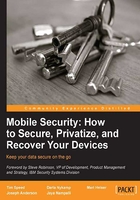
Foreword
Today, nearly every individual uses some kind of intelligent mobile device and for you, the end user, it is important to understand the risks inherent in using these devices. The benefit is obvious, but keeping yourself and your family safe in this mobile world is more essential than ever. Mobile Security: How to Secure, Privatize, and Recover Your Devices will be invaluable to those who want to know how to protect themselves in this new mobile world. The authors explain how to protect your device, as well as the actions you should take in the event that your personal information or device is compromised. This book is intended as a guide; it has thus been organized for convenient reference in addressing the issues and challenges inherent in navigating the new mobile world.
Contained within this book is a list of available mobile devices and their uses. Also, features such as Facebook, LinkedIn, Connection, Groupon, and others are discussed with regards to their potential for exposing users to risk. Mobile banking and purchases are also included in this discussion. Exposure of our financial information to potential hackers should be of major concern to those that participate in these activities. On a related note, Cloud computing is addressed and defined, with particular attention paid to the risks and security weaknesses of this increasingly important popular technology.
The inclusion of Mobile Device Management (MDM) is significant because of the increasing number of personal devices, which are used at work. When your personal device connects to a company's trusted network, your employer's security measures must be put into effect. These security measures go far beyond simply creating new passwords. One issue identified and discussed in this book is personally downloaded programs. These applications may contain viruses, which may therefore place your employer's proprietary information at risk. This handbook will help you to understand how to protect yourself and your employer.
We all interact with our world using a variety of mobile devices. To verify our identification, we are forced to enter personal information. This information is now held by numerous sites, banks, social media, mobile storefronts, cell phone carriers, and many more. This book explains what these sites do with your information and the control you, as an individual, have. Everyone needs to understand the privacy and customer information polices of any business to which they provide their personal information.
The threats and challenges, which users in the mobile world may encounter, are presented in a detailed and easy-to-understand format. This book provides a list of actions the users can take to protect themselves, such as how to strengthen passwords and techniques for encrypting personal data. The possibility that a hacker is able to circumvent such preventative measures is also addressed. You as an end user are not helpless against hackers. A comprehensive list of steps to take in case a hacker is successful is included. There is also a guide on how to inform law enforcement, and what to expect afterwards.
Protecting your devices is, however, the primary focus of this book. Therefore, a discussion of insurance and third-party tools that can keep your device and information safe is included. Monitoring your credit through services such as Lifelock is also covered. As part of this discussion, this handbook also covers in detail the steps you can take to remove your private information from websites such as Facebook or Twitter.
The section on future scenarios is useful and timely, as it discusses the trajectory of mobile technology and security. Some of the options mentioned are already available to the general public; those that are not yet publicly available may be in the very near future. Our society is moving away from the brick-and-mortar consumer world of yesterday. Paper money is slowly going the path of paper checks. Our information will have to be available in this virtual society and therefore, the value of such information will only increase. Correspondingly, it is more essential than ever that we learn how to better protect ourselves; this book provides techniques tailored for this new and more challenging environment.
Chapter 8, Getting Your Life Back After You've Been Hacked, is a template where the reader can enter the information they will need in case their information is in danger of being compromised. It is a useful tool, as reacting in a timely manner is essential. I recommend you take time to fill it out.
Steve Robinson
VP of Development, Product Management and Strategy, IBM Security Systems Division